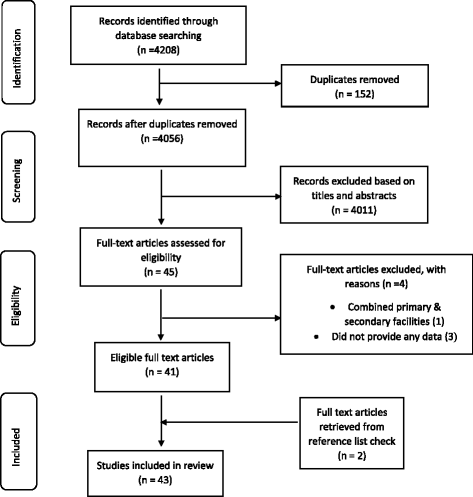Prescribing indicators at primary health care centers within the WHO African region: a systematic analysis (1995-2015)
- PMID: 27545670
- PMCID: PMC4993007
- DOI: 10.1186/s12889-016-3428-8
Prescribing indicators at primary health care centers within the WHO African region: a systematic analysis (1995-2015)
Abstract
Background: Rational medicine use is essential to optimize quality of healthcare delivery and resource utilization. We aim to conduct a systematic review of changes in prescribing patterns in the WHO African region and comparison with WHO indicators in two time periods 1995-2005 and 2006-2015.
Methods: Systematic searches were conducted in PubMed, Scopus, Web of science, Africa-Wide Nipad, Africa Journals Online (AJOL), Google scholar and International Network for Rational Use of Drugs (INRUD) Bibliography databases to identify primary studies reporting prescribing indicators at primary healthcare centres (PHCs) in Africa. This was supplemented by a manual search of retrieved references. We assessed the quality of studies using a 14-point scoring system modified from the Downs and Black checklist with inclusions of recommendations in the WHO guidelines.
Results: Forty-three studies conducted in 11 African countries were included in the overall analysis. These studies presented prescribing indicators based on a total 141,323 patient encounters across 572 primary care facilities. The results of prescribing indicators were determined as follows; average number of medicines prescribed per patient encounter = 3.1 (IQR 2.3-4.8), percentage of medicines prescribed by generic name =68.0 % (IQR 55.4-80.3), Percentage of encounters with antibiotic prescribed =46.8 % (IQR 33.7-62.8), percentage of encounters with injection prescribed =25.0 % (IQR 18.7-39.5) and the percentage of medicines prescribed from essential medicines list =88.0 % (IQR 76.3-94.1). Prescribing indicators were generally worse in private compared with public facilities. Analysis of prescribing across two time points 1995-2005 and 2006-2015 showed no consistent trends.
Conclusions: Prescribing indicators for the African region deviate significantly from the WHO reference targets. Increased collaborative efforts are urgently needed to improve medicine prescribing practices in Africa with the aim of enhancing the optimal utilization of scarce resources and averting negative health consequences.
Keywords: Africa; Drug use indicators; Medicine utilization studies; Pharmacoepidemiology; Prescribing evaluation; Prescribing indicators; Systematic reviews.
Figures
References
-
- World Health Organization . The world medicines situation. Geneva: World Health Organization; 2004.
-
- Laing R. Rational drug use; an unsolved problem. Trop Dr. 1990;20:101–103. - PubMed
-
- Massele A, Burger J, Katende-Kyenda NL, Kalemeera F, Kenaope T, Kibuule D, Mbachu O, Mubita M, Oluka M, Olusanya A, et al. Outcome of the first Medicines Utilization Research in Africa group meeting to promote sustainable and rational medicine use in Africa. Expert Rev Pharmacoecon Outcomes Res. 2015;15(6):885–888. doi: 10.1586/14737167.2015.1088386. - DOI - PubMed
-
- World Health Organization . World medicines situation report 2011. Geneva: World Health Organization; 2011.
Publication types
MeSH terms
Substances
LinkOut - more resources
Full Text Sources
Other Literature Sources
Medical


